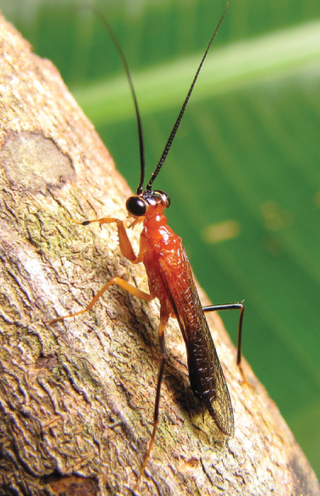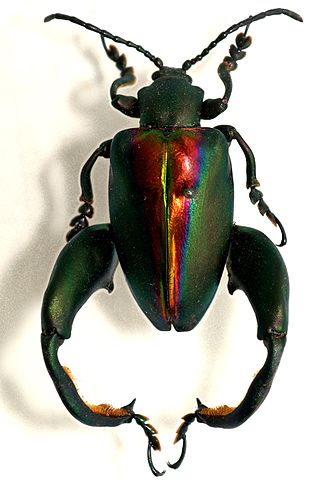
The Cupedidae are a small family of beetles, notable for the square pattern of "windows" on their elytra, which give the family their common name of reticulated beetles.

Mantidae is one of the largest families in the order of praying mantises, based on the type species Mantis religiosa; however, most genera are tropical or subtropical. Historically, this was the only family in the order, and many references still use the term "mantid" to refer to any mantis. Technically, however, "mantid" refers only to members of the family Mantidae, and not the 14 remaining families of mantises. Some of the most recent classifications have promoted a number of the mantid subfamilies to the rank of family, e.g. Iridopterygidae, Sibyllidae, Tarachodidae, Thespidae, and Toxoderidae, while other classifications have reduced the number of subfamilies without elevating to higher rank.
The Thanetian is, in the ICS Geologic timescale, the latest age or uppermost stratigraphic stage of the Paleocene Epoch or Series. It spans the time between 59.2 and56 Ma. The Thanetian is preceded by the Selandian Age and followed by the Ypresian Age. The Thanetian is sometimes referred to as the Late Paleocene.

The Tettigarctidae, known as the hairy cicadas, are a small relict family of primitive cicadas. Along with more than 20 extinct genera, Tettigarctidae contains a single extant genus, Tettigarcta, with two extant species, one from southern Australia and one from the island of Tasmania. Numerous fossil species have been described from the Late Triassic onwards. Tettigarcta are the closest living relatives of the true cicadas.

Evaniidae is a family of parasitoid wasps also known as ensign wasps, nightshade wasps, hatchet wasps, or cockroach egg parasitoid wasps. They number around 20 extant genera containing over 400 described species, and are found all over the world except in the polar regions. The larvae of these solitary wasps are parasitoids that feed on cockroaches and develop inside the egg-cases, or oothecae, of their hosts.

The moonfish of the genus Mene, the sole extant genus of the family Menidae, are disk-shaped fish which bear a vague resemblance to gourami, thanks to their thread-like pelvic fins. Today, the genus is represented only by Mene maculata of the Indo-Pacific, where it is a popular food fish, especially in the Philippines, where it is known as bilong-bilong, chabita, hiwas or tahas.
The Paleocene, or Palaeocene, is a geological epoch that lasted from about 66 to 56 million years ago (mya). It is the first epoch of the Paleogene Period in the modern Cenozoic Era. The name is a combination of the Ancient Greek παλαιός palaiós meaning "old" and the Eocene Epoch, translating to "the old part of the Eocene".

Cupes is a genus of beetles in the family Cupedidae. The Cupedidae are typical “reticulate” or “net-winged” beetles with incompletely sclerotized elytra that produce the characteristic reticulate appearance.

Mantoididae is a family of praying mantises which contains Neotropical species of praying mantises from tropical North and South America. The family was formerly represented by the sole genus Mantoida, until the genus Paramantoida was described in 2014 and Vespamantoida in 2019. The family differs from the closely related Chaeteessidae in having an apical claw on the fore tibiae which are also less curved. Males have ocelli and a cylindrical body shape, unlike the dorsoventrally flattened Chaeteessidae. The cerci are also shorter.

Issidae is a family of planthoppers described by Spinola in 1839, belonging to the order Hemiptera, suborder Auchenorrhyncha superfamily Fulgoroidea.

Didolodontidae is a possibly paraphyletic family of "condylarth" mammals known from the Paleogene of South America, with most specimens known from Argentina. They were generally small-medium in body size, and had a bunodont dentition. A close relationship with litopterns has been suggested by some studies. They range in age from the early Paleocene (Selandian/Peligran) to late Eocene (Priabonian/Mustersan). The attribution of Salladolodus deuterotheroides from the Late Oligocene of Bolivia to the family is doubtful.
Microphorites is an extinct genus of flies in the family Dolichopodidae.
Cretomantidae is an extinct family of mantises in the order Mantodea. It contains at least one genus Cretomantis, which is known from the Early Cretaceous Zaza Formation of Buryatia, Russia. The genus Electromantis known from Late Cretaceous (Santonian) Taimyr amber of Russia was formerly placed in this family, but is currently considered incertae sedis within Mantodea.
Electrentomidae is an extinct family of barklice, booklice, and parasitic lice in the order Psocodea. There are about six genera and seven described species in Electrentomidae. The family was synonymsed with the extant family Manicapsocidae in 2003 without discussion, with a prior proposal in 1972, but Azar et al., 2017, stated that "we consider herein [Electrentomidae and Manicapsocidae] apart, because a cladistic phylogenetic analysis is needed prior to taking such important decision for these groups."
2019 in paleoentomology is a list of new fossil insect taxa that were described during the year 2019, as well as other significant discoveries and events related to paleoentomology that were scheduled to occur during the year.

The Sagrinae are a subfamily of the leaf beetles, or Chrysomelidae.
Manicapsocidae is a family of Psocodea. It contains 8 extant species in 4 genera, with most of the species being found in the Neotropics, with one species in the Afrotropics. The extinct family Electrentomidae has been suggested to be a synonym of this family, though this has been considered premature by other scholars in the absence of cladistic analysis. Confirmed fossil species of the family are nearly as numerous as living ones, extending back to the Mid-Cretaceous.

Elcanidae are an extinct family of Mesozoic and early Cenozoic orthopterans. Members of the family are distinguished by the presence of spurs on the distal part of the metatibia, unique among orthopterans, these have been suggested to have been used for controlling gliding, swimming aids, or for jumping on water. The group combines characteristics from both major groups of orthopterans, with long antennae and nymphal morphology similar to Ensifera, but with wing venation and adult morphology more similar to Caelifera. Elcanidae is part of Elcanoidea, which is thought to have diverged from living orthopterans by the beginning of the Permian, around 300 million years ago. The family also includes Permelcanidae, known from the Early-Late Permian. The relationship of Elcanoidea to Ensifera and Caelifera is currently unresolved. Elcanids are known from the Late Triassic to Paleocene of Eurasia, North and South America. Some members of the group exhibited aposematic coloration.
Cupes manifestus is an extinct species of reticulated beetle in the family Cupedidae and the genus Cupes. It is known from Selandian crater lake diatomite in the Menat Formation of France.

Promastax is a genus of "monkey grasshoppers" belonging to the extinct monotypic family Promastacidae and containing the single species Promastax archaicus. The species is dated to the Early Eocenes Ypresian stage and has only been found at the type locality in east central British Columbia.












